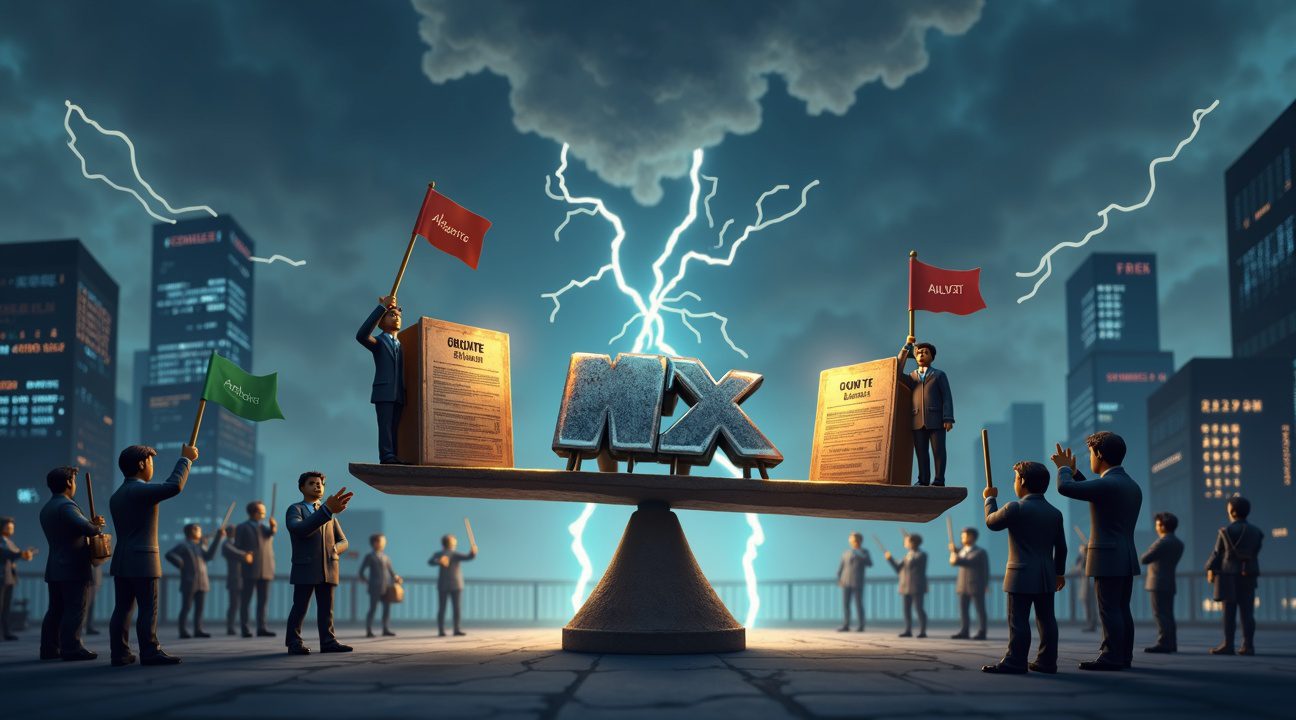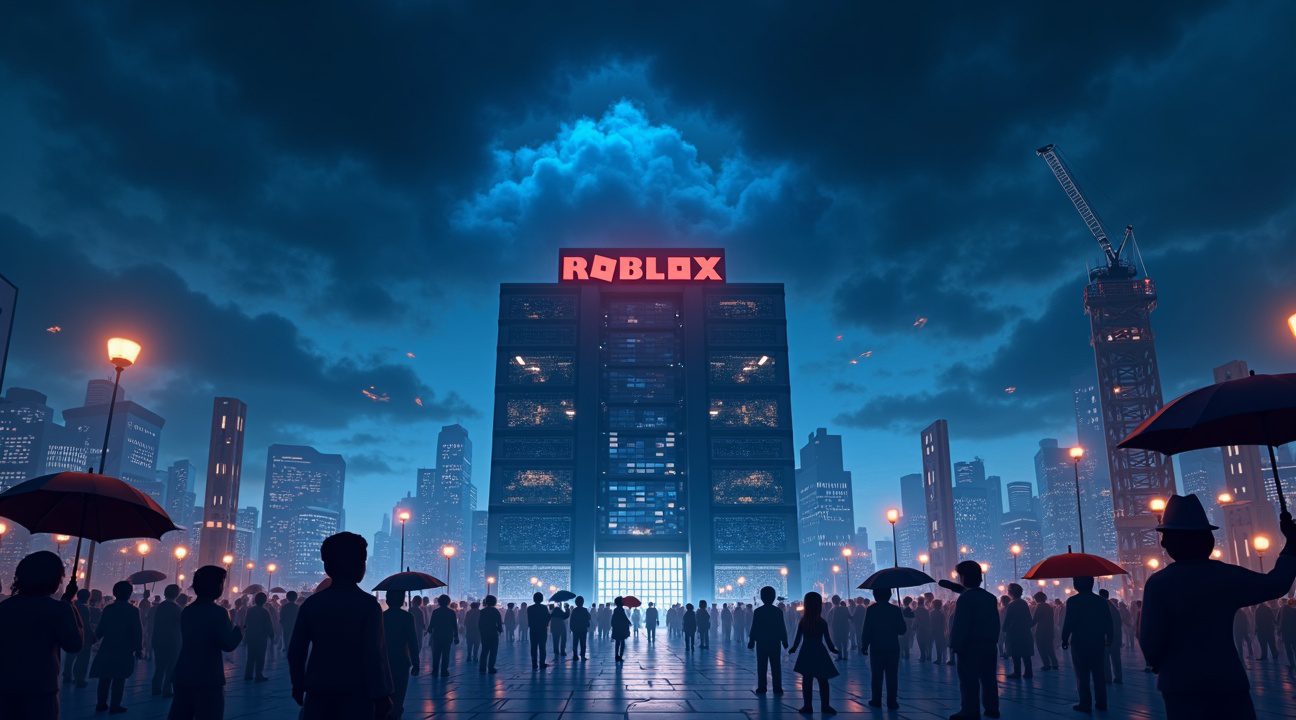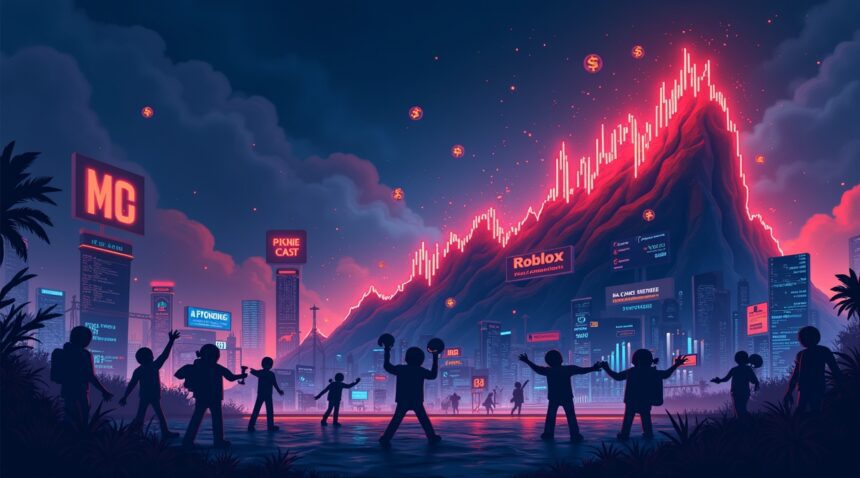Roblox Corporation is navigating a striking disconnect between its strong operational performance and declining market sentiment, shedding $12.17 billion in market capitalization over just 11 days—even after reporting a solid second-quarter performance.
Key Takeaways
- Roblox lost $12.17 billion in market value, falling from $93.51 billion to $81.34 billion despite robust Q2 results.
- Q2 highlights included $1.1 billion in revenue (21% growth), $1.4 billion in bookings (51% growth), and a rise in paying users from 16.5 million to 23.4 million year-over-year.
- Management raised full-year bookings guidance to between $5.87 billion and $5.97 billion, with projected free cash flow of over $1 billion for 2025, despite posting a $0.41 per-share loss.
- The stock trades at nearly 100x projected 2025 free cash flow, raising valuation concerns even as 19 analysts maintain ‘buy’ ratings and only 2 issue ‘sell’ recommendations.
- Regulatory scrutiny and child safety concerns continue to pressure the stock, with rising compliance costs threatening future profitability.
Financial Performance Analysis
Roblox delivered exceptional second-quarter results that under normal market conditions would likely result in investor optimism and price appreciation. Revenue climbed to $1.1 billion, marking a 21% increase from the previous year. Bookings soared by 51% to $1.4 billion, indicating heightened user activity and stronger monetization.
Paying users grew significantly from 16.5 million to 23.4 million year-over-year, underscoring effective platform engagement strategies. Management further lifted full-year bookings expectations to between $5.87 and $5.97 billion. Additionally, the company projects generating over $1 billion in free cash flow in 2025—an important forward-looking metric.
Despite these promising fundamentals, the company reported a net loss of $0.41 per share. Nevertheless, user engagement metrics remained strong, with daily active users reaching 79.5 million and total hours engaged rising by 24% annually. Average bookings per daily user improved to $4.28, a signal of enhanced per-user monetization.
Valuation Concerns Drive Selloff
The main driver of Roblox’s recent selloff stems from valuation-based anxieties. The stock trades at close to 100 times its revised 2025 free cash flow guidance—a figure that appears inflated compared to legacy tech firms with similarly aggressive growth trajectories.
Wall Street remains optimistic, with 19 analysts rating the stock a ‘buy’ and only 2 classifying it as a ‘sell’. Nevertheless, institutional investors question whether such valuations can be justified in a competitive landscape. The gap between analyst ratings and actual price movement suggests a more nuanced market sentiment and potential structural weaknesses in the stock.
With new entrants in the online gaming industry and existing platforms enhancing their offerings, investors grow cautious about Roblox’s ability to hold or expand its market share, which could cap future growth potential.
Regulatory Pressure and Safety Concerns
Roblox faces increasing regulatory pressure, particularly on the issue of child safety—a core area of concern given its youthful user base. As governments worldwide intensify scrutiny, platforms serving minors must prioritize user protection. Meeting these standards often entails significant compliance expenditures, potentially squeezing profit margins.
Also, legal challenges questioning Roblox’s approach to safeguarding users have persisted. These developments extend beyond immediate financial liability to challenge the company’s brand image and user trust. Regulatory actions might eventually compel substantial operational changes, the costs of which could hinder financial flexibility and innovation.
The platform must find a productive balance, preserving its open, creative ecosystem while ensuring safety enhancements that comply with evolving legal standards across global jurisdictions.
Market Outlook and Investment Implications
Despite the market downturn, Roblox’s platform fundamentals remain resilient. Continued growth in users and engagement, combined with strong revenue and bookings figures, reflect a sturdy core business. The milestone of surpassing $1 billion in expected free cash flow by 2025 could mark a pivotal transition toward sustained profitability.
Nevertheless, volatility will likely persist in the near term as investors evaluate long-term growth against near-term valuation and regulatory pressure. A favorable resolution to safety concerns may serve as a catalyst for renewed investor confidence and price recovery.
For long-term investors, the focus should remain on Roblox’s entrenched position in user-generated content and its robust virtual economy—both key pillars in the rising metaverse ecosystem. These strengths could enable durable growth as digital worlds gain wider adoption.
Ultimately, the recent selloff may represent a strategic entry point for investors with a higher risk tolerance and long-term perspective. However, staying informed about structural risks, especially valuation and compliance costs, is essential before making any investment decisions.
Massive $12.17 Billion Market Value Wipeout in Just 11 Days
I’ve witnessed some stunning market movements in gaming stocks, but Roblox’s recent collapse stands out as particularly dramatic. The platform giant has shed approximately $12.17 billion in market capitalization since August 6, 2025, marking one of the most significant value destructions in recent gaming industry history.
The numbers tell a stark story. Roblox’s market cap plummeted from around $93.51 billion earlier this month to $81.34 billion as of August 17, 2025. This massive selloff dropped the company to 257th place among the most valuable public companies globally by market value, a position that reflects investor uncertainty about the platform’s immediate prospects.
Extreme Stock Volatility Reflects Market Uncertainty
Stock performance data reveals the extent of this financial turbulence. Shares closed at $125.28, opened at $113.83, and last traded around $116.31, creating wild swings that have left traders scrambling to understand the underlying causes. This volatility becomes even more striking when I consider the stock’s recent journey from extreme lows to highs and back again.
The current decline follows a remarkable surge that saw shares reach $150.59, more than doubling from April’s low of $50. Such dramatic price movements suggest institutional investors are reassessing their positions, possibly triggered by concerns about:
- User growth
- Monetization challenges
- Broader market conditions affecting tech stocks
What makes this selloff particularly noteworthy is its speed and magnitude. Losing over $12 billion in market value within just 11 days indicates significant institutional selling pressure. Major funds and investment firms appear to be repositioning their portfolios, potentially moving capital away from gaming platforms and tribute initiatives toward other sectors.
The timing of this decline coincides with broader market pressures affecting technology companies. Gaming stocks have faced increased scrutiny from regulators and investors questioning long-term growth sustainability. Roblox’s particular challenges may include:
- User acquisition costs
- Competition from other platforms
- Questions about maintaining engagement levels among its core demographic
Market analysts are closely watching whether this represents a temporary correction or signals deeper structural concerns about Roblox’s business model. The company’s ability to stabilize its stock price and restore investor confidence will likely depend on upcoming earnings reports and management’s strategic responses to current market conditions.
For investors tracking gaming platform developments, this situation demonstrates how quickly market sentiment can shift in the volatile gaming sector.
Record-Breaking User Growth Drives Massive Bookings Surge
Roblox’s Q2 2025 financial results showcase remarkable growth across key metrics, even as the company faces market volatility. I’ve observed how the platform’s revenue reached $1.1 billion, marking a solid 21% year-over-year increase that surpassed analyst expectations. This performance demonstrates the platform’s resilience in maintaining growth momentum despite broader market pressures.
The bookings surge tells an even more compelling story, with $1.4 billion representing an impressive 51% growth compared to the same period last year. This substantial increase in bookings reflects stronger user engagement and spending patterns across the platform. The gap between revenue and bookings indicates healthy deferred revenue streams that will benefit future quarters.
Expanding User Base Across All Demographics
The platform’s user expansion has been particularly striking, with paying users growing from 16.5 million to 23.4 million year-over-year. This represents a significant milestone in monetization efforts, showing that more users are willing to invest real money in their Roblox experiences. The conversion rate improvements suggest that the platform’s value proposition continues to resonate with its community.
Daily active users and total hours spent on the platform reached record levels, with particularly strong performance among users aged 13 and older. I’ve noticed that this demographic logged 17% growth, which is crucial for long-term platform sustainability since older users typically have higher spending power and retention rates. Gaming platforms that successfully engage teenage and adult audiences often see more stable revenue streams.
Viral games like ‘Grow a Garden’ have played a significant role in driving user expansion and engagement, especially within the older teen demographic. These breakout titles demonstrate how user-generated content can create viral moments that attract new users and re-engage existing ones. The success of such games highlights the platform’s ability to foster creativity while maintaining broad appeal across different age groups.
The combination of strong financial metrics and user growth indicates that Roblox’s fundamental business model remains sound. While market capitalization fluctuations reflect investor sentiment and broader economic factors, the underlying user engagement and monetization trends suggest a platform that continues to execute on its core strategy effectively. Popular gaming titles often face similar market volatility despite strong operational performance.
Strong Bookings Growth Prompts Management to Raise Full-Year Outlook
Roblox’s leadership team has demonstrated confidence in the platform’s trajectory by revising their full-year bookings forecast upward significantly. The company now projects bookings between $5.87 billion and $5.97 billion, representing more than a 10% increase from their previous estimates. This upward revision reflects the platform’s continued ability to drive user engagement and monetization across its virtual experiences.
Impressive Cash Flow Projections Signal Financial Momentum
Looking ahead to 2025, Roblox anticipates generating over $1 billion in free cash flow, which would represent a substantial 60% year-over-year increase. This projection suggests the company’s operational efficiency improvements are beginning to translate into meaningful cash generation. The strong cash flow outlook provides management with greater flexibility for strategic investments and platform development initiatives.
Gaming companies across the industry have been focusing on sustainable growth models, and Roblox’s cash flow projections align with broader trends toward PlayStation’s strategic initiatives that prioritize long-term value creation over short-term gains.
Profitability Challenges Persist Despite Revenue Strength
While the bookings and cash flow metrics paint an optimistic picture, Roblox continues to face profitability headwinds. The company reported a loss of $0.41 per share, which fell short of analyst expectations and highlighted ongoing operational challenges. These losses underscore the tension between aggressive growth investments and near-term profitability targets.
Management’s decision to reduce the 2025 EBITDA outlook to slightly negative territory signals that profitability remains elusive despite strong top-line performance. This adjustment reflects the company’s commitment to continued platform investment, even as it weighs on short-term financial metrics. The gaming industry has seen similar patterns with other major platforms, including recent developments in Overwatch 2’s expansion strategy that prioritizes market reach over immediate returns.
Roblox’s financial profile mirrors many high-growth technology companies that prioritize market expansion and user acquisition over immediate profitability. The company’s ability to generate strong bookings growth while building toward substantial free cash flow generation suggests a maturing business model. However, the persistent losses and negative EBITDA outlook indicate that management hasn’t yet found the optimal balance between growth investments and operational efficiency.
The revised outlook creates an interesting dynamic for investors who must weigh the platform’s demonstrated ability to drive user engagement against its continued struggle to convert that engagement into sustainable profits. Entertainment companies have faced similar challenges, as seen with recent industry developments like Netflix’s content investment strategies that balance growth with profitability concerns.
Roblox’s financial trajectory reflects the complex economics of user-generated content platforms, where the company must invest heavily in infrastructure, safety systems, and creator tools while monetizing through virtual transactions. The strong bookings growth suggests users continue to find value in the platform’s offerings, but converting this engagement into sustainable margins remains an ongoing challenge for management.
Profitability Challenges Persist Despite Revenue Boom
Roblox finds itself in a peculiar position where impressive revenue growth fails to translate into profitability. The company continues reporting net losses quarter after quarter, even as bookings surge and user engagement reaches new heights. This disconnect between top-line performance and bottom-line results has become a central concern for investors and analysts tracking the gaming platform’s financial trajectory.
Revenue streams keep expanding as millions of users purchase Robux, the platform’s virtual currency, yet operational expenses consistently outpace income generation. Marketing costs, infrastructure investments, and content creator payments drain resources faster than the company can generate sustainable profits. I’ve observed that while gaming platforms often struggle with monetization early on, Roblox’s extended profitability timeline raises questions about its fundamental business model efficiency.
Viral Game Dependency Creates Uncertainty
The platform’s heavy reliance on viral games presents significant risks that traditional gaming companies don’t face. When a game like “Adopt Me!” or “Brookhaven” captures widespread attention, user engagement and spending spike dramatically. However, these viral moments prove difficult to predict or sustain, creating volatile revenue patterns that make financial forecasting challenging.
Several factors contribute to this unpredictability:
- User attention spans on Roblox tend to be shorter than traditional gaming platforms
- New viral games can quickly overshadow established favorites
- Developer-created content quality varies significantly across the platform
- Seasonal trends heavily influence which games gain traction
- Platform algorithm changes can dramatically impact game visibility
Analysts express concern about building a sustainable business model around such unpredictable engagement patterns. Unlike subscription-based services or traditional game sales, Roblox’s revenue depends on maintaining constant user excitement and discovery. This creates pressure to continuously identify and promote the next viral sensation, requiring substantial resources and sophisticated prediction capabilities.
The company’s attempts to diversify beyond gaming into educational content and virtual events show promise but haven’t yet generated significant revenue impact. Entertainment platforms often face similar challenges when expanding into new content categories, though Roblox’s user-generated model adds complexity to content quality control and monetization strategies.
Operational efficiency remains questionable as the company scales its infrastructure to support growing user bases across multiple geographic regions. Server costs, content moderation expenses, and developer revenue sharing eat into margins significantly. While competitors like Minecraft have found ways to maintain profitability despite large user bases, Roblox’s decentralized content creation model requires different cost structures and support systems.
The gap between strong performance metrics and financial losses suggests structural issues within the business model itself. Revenue growth without corresponding profit improvement indicates that either costs scale too aggressively with user acquisition or that monetization strategies aren’t optimized for sustainable returns. Gaming industry trends show that successful platforms typically achieve profitability within their first few years of major growth phases.
Management’s continued emphasis on long-term growth over short-term profitability reflects confidence in eventual margin improvements, yet skeptics question whether the current trajectory supports such optimism. The platform’s unique position between social media and gaming creates opportunities but also complicates traditional profitability models that investors understand and value.
Market conditions have become less forgiving of growth-without-profit stories, particularly in the technology sector. Platform operators increasingly need to demonstrate clear paths to profitability rather than relying solely on user growth metrics. Roblox’s challenge lies in proving that its massive user engagement can eventually convert into sustainable profit margins while maintaining the creative freedom that attracts both developers and players to the platform.

Mixed Analyst Sentiment Reflects Valuation Concerns
Roblox’s current market position presents a fascinating paradox that I find particularly intriguing. Wall Street analysts display a cautiously optimistic stance, with 19 analysts rating the stock as a ‘buy’ compared to just 2 recommending a ‘sell’. This distribution creates an overall consensus of ‘Moderate Buy’, suggesting professional investors maintain faith in the platform’s long-term potential despite recent market turbulence.
The most pressing concern centers on valuation metrics that appear stretched by traditional standards. Roblox currently trades at nearly 100 times its revised 2025 free cash flow guidance, a multiple that raises eyebrows even among growth-focused investors. This astronomical valuation reflects the premium market participants assign to the company’s growth prospects, yet it also creates vulnerability during periods of market uncertainty or disappointing performance.
Institutional Positioning and Market Dynamics
Short interest data reveals an interesting dynamic that contradicts the dramatic sell-off. At just 2.81%, the percentage of shares sold short remains relatively modest, indicating that institutional investors aren’t aggressively betting against the stock. This low short interest suggests that while concerns exist about current valuations, few professional traders expect a complete collapse in Roblox’s business model.
External factors beyond financial metrics have compounded the stock’s challenges. Child safety issues and ongoing legal scrutiny have generated negative headlines that impact investor sentiment regardless of underlying business performance. These concerns create additional pressure on the stock price, as investors weigh potential regulatory risks against growth opportunities.
The disconnect between analyst recommendations and recent stock performance highlights the complexity of valuing high-growth technology platforms. While analysts maintain generally positive outlooks based on user engagement metrics and platform expansion, market participants appear increasingly sensitive to valuation concerns and external risks. This tension between fundamental optimism and market caution continues to drive volatility in Roblox shares.
Gaming industry dynamics add another layer of complexity, as companies like Overwatch 2 and other major franchises compete for user attention and engagement. The competitive landscape requires continuous innovation and investment, potentially affecting long-term profitability projections that underpin current analyst models.

Regulatory Pressure and Safety Concerns Cloud Growth Story
Roblox finds itself under increasing scrutiny from regulators and lawmakers who’ve raised serious questions about child safety on the platform. The company’s stock has suffered as ongoing legal challenges and regulatory investigations continue to weigh heavily on investor confidence. Despite minimal short interest in the stock, negative headlines about safety incidents have created persistent downward pressure on share prices.
These regulatory headwinds represent more than temporary obstacles for Roblox’s business model. Government agencies have begun examining how the platform moderates content and protects its predominantly young user base. Each safety-related controversy generates fresh concerns among institutional investors who question whether current safeguards adequately protect children from inappropriate content and predatory behavior.
Long-Term Business Implications
The mounting regulatory pressure threatens to fundamentally alter how Roblox operates and grows its platform. Potential new regulations could force the company to implement costly safety measures that might limit user engagement or slow down content creation. These changes could significantly impact the company’s ability to attract new users and retain existing ones, particularly if safety restrictions make the platform less appealing to its core demographic.
Investment analysts have noted that safety concerns create uncertainty around Roblox’s future revenue streams and growth trajectory. The company may need to allocate substantial resources toward compliance and safety infrastructure rather than expanding its gaming ecosystem. This shift in priorities could affect profitability margins and delay key product launches that investors expect to drive future growth.
Market sentiment has turned increasingly cautious as investors weigh these regulatory risks against Roblox’s growth potential. The gaming industry has seen similar safety concerns impact other platforms, and investors remember how quickly regulatory action can reshape business models. While companies like Overwatch 2 continue expanding their reach, Roblox faces unique challenges related to its younger user base that other gaming platforms don’t encounter.
The uncertainty surrounding potential regulatory changes has made many institutional investors hesitant to increase their positions in Roblox stock. Fund managers express concerns that future compliance costs could eat into profit margins while simultaneously limiting the platform’s appeal to users. These factors combine to create a challenging environment where even positive earnings reports struggle to overcome safety-related skepticism among investors.

Sources:
MarketBeat, “Roblox (NYSE:RBLX) Shares Gap Down – Here’s Why”
AI Economic Times, “Roblox Q2 2025 earnings: Roblox surges 16% after booking boom”
CompaniesMarketCap, “Roblox (RBLX) – Market capitalization”
TipRanks, “Roblox (RBLX) Earnings Dates, Call Summary & Reports”
Bay Street, “Beware of Selling Pressure on Roblox, CoreWeave, and …”
Morningstar, “Roblox Earnings: Eye-Popping Sales and User Engagement, but …”
Roblox Investor Relations, “Roblox Reports Second Quarter 2025 Financial Results”
MLQ.ai, “Roblox (RBLX) Q2 2025 Earnings”


